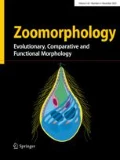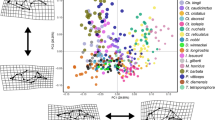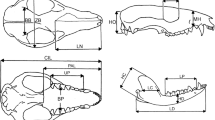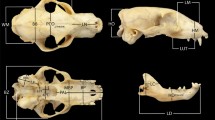Abstract
As with many other amphibians, Triturus species are characterized by a biphasic life cycle with abrupt changes in the cranial skeleton during metamorphosis. The post-metamorphic shape changes of the cranial skeleton were investigated using geometric morphometric techniques in six species: Triturus alpestris, T. vulgaris, T. dobrogicus, T. cristatus, T. carnifex, and T. karelinii. The comparative analysis of ontogenetic trajectories revealed that these species have a conserved developmental rate with divergent ontogenetic trajectories of the ventral skull shape that mainly reflect phylogenetic relatedness. A striking exception in the ontogenetic pattern was possibly found in T. dobrogicus, characterized by a marked increase in the developmental rate compared to the other newt species. The size-related shape changes explained a large proportion of shape change during post-metamorphic growth within each species, with marked positive allometric growth of skull elements related to foraging.




Similar content being viewed by others
References
Adams DC, Rohlf FJ, Slice DE (2004) Geometric morphometrics: ten years of progress following the ‘revolution’. Ital J Zool 71:5–16
Alberch P, Gould SJ, Oster GF, Wake DB (1979) Size and shape in ontogeny and phylogeny. Paleobiology 5:296–317
Arntzen JW (2000) A growth curve for the newt Triturus cristatus. J Herpetol 34:227–232
Birch JM (1999) Skull allometry in the marine toad, Bufo marinus. J Morphol 241:115–126
Bolkay StJ (1928) Die schädel der salamandrinen, mit besonderer rückicht auf ihre systematische bedeutung. Zeitshrift für anatomie und entwicklungsgechichte 86:260–319
Bookstein FL (1991) Morphometric tools for landmark data: geometry and biology. Cambridge University Press, Cambridge, UK
Bookstein FL (1996) Combining the tools of geometric morphometrics. In: Marcus LF, Corti M, Loy A, Nayulor GJP, Slice DE (eds) Advances in morphometrics. Plenum Press, New York, pp 131–151
Cane WP (1993) The ontogeny of postcranial integration in the common tern, Sterna hirundo. Evolution 47:1138–1151
Cardini A (2003) The geometry of the marmot (Rodentia: Sciuridae) mandible: phylogeny and patterns of morphological evolution. Syst Biol 52:186–205
Cardini A, O’Higgins P (2004) Patterns of morphological evolution in Marmota (Rodentia, Sciuridae): geometric morphometrics of the cranium in the context of marmot phylogeny, ecology and conservation. Biol J Linn Soc 82:385–407
Dingerkus G, Uhler LD (1977) Enzyme clearing of alcian blue stained whole small vertebrates for demonstration of cartilage. Stain Technol 52:229–232
Djorović A, Kalezić ML (2000) Paedogenesis in European newts (Triturus: Salamandridae): cranial morphology during ontogeny. J Morphol 243:127–139
Dryden IL, Mardia KV (1998) Statistical shape analysis. Wiley, New York
Duellman WE, Trueb L (1986) Biology of amphibians. McGraw Hill, New York
Emerson SB, Bramble DM (1993) Scaling, allometry, and skull design. In: Hanken J, Hall BK (eds) The skull. Functional and evolutionary mechanisms, vol 3. The University of Chicago Press, Chicago, pp 384–421
Gould SJ (1977) Ontogeny and phylogeny. Harvard University Press, Cambridge, MA
Griffiths RA (1996) Newts and salamanders of Europe. Academic, San Diego, CA
Goodall CR (1991) Procrustes methods in the statistical analysis of shape. J R Stat Soc B 53:285–339
Hagström T (1977) Growth studies and ageing methods for adult Triturus vulgaris L. and T. cristatus Laurenti (Urodela, Salamandridae). Zool Scr 6:61–68
Ivanović A, Kalezić ML, Aleksić I (2005) Morphological integration of cranium and postcranial skeleton during ontogeny of paedomorphic European newts (Triturus vulgaris and T. alpestris). Amphibia-Reptilia 26:485–495
Klingenberg CP (1998) Heterochrony and allometry: the analysis of evolutionary change in ontogeny. Biol Rev 73:79–123
Larson PM (2004) Chondrocranial morphology and ontogenetic allometry in larval Bufo americanus (Anura, Bufonidae). Zoomorphology 123:95–106
Larson PM (2005) Ontogeny, phylogeny, and morphology in anuran larvae: morphometric analysis of cranial development and evolution in Rana tadpoles (Anura: Ranidae). J Morphol 264:34–52
Lebedkina NS (2004) Evolution of the amphibian skull. In: Kuzmin SL (ed) Advances in amphibian research in the Former Soviet Union, vol 9. Pensoft Publishers, Sofia, pp 1–239
Macgregor HC, Sessions SK, Arntzen JW (1990) An integrative analysis of phylogenetic relationships among newts of the genus Triturus (Family Salamandridae), using comparative biochemistry, cytogenetics and reproductive interactions. J Evol Biol 3:329–373
McKinney ML, McNamara KJ (1991) Heterochrony: the evolution of ontogeny. Plenum Press, New York
Miaud C, Guyetant R, Faber H (2000) Age, size, and growth of the alpine newt, Triturus alpestris (Urodela: Salamandridae), at high altitude and review of life-history trait variation throughout its range. Herpetologica 56:135–144
Mitteroecker P, Gunz P, Bookstein FL (2005) Heterochrony and geometric morphometrics: a comparison of cranial growth in Pan panicus versus Pan troglodytes. Evol Dev 7:244–258
Monteiro LR (1999) Multivariate regression models and geometric morphometrics: the search for causal factors in the analysis of shape. Syst Biol 48:192–199
Monteiro LR, Lessa LG, Abe AS (1999) Ontogenetic variation in skull shape of Thrichomys apereoides (Rodentia: Echimyidae). J Mammal 80:102–112
Moss ML, Young RW (1960) A function approach to craniology. Amer J Phys Anthropol 18:281–292
Olgun K, Uzum N, Avci A, Miaud C (2005) Age, size and growth of the southern crested newt Triturus karelinii (Strauch 1870) in a population from Bozdag (Western Turkey). Amphibia-Reptilia 26:223–230
Reilly SM (1990) Comparative ontogeny of cranial shape in salamanders using resistant fit theta rho analysis. In: Rohlf FJ, Bookstein FL (eds) Proceedings of the Michigan morphometrics workshop. University of Michigan Museum of Zoology, Special Publication Number 2, pp 311–321
Rose CS (2003) The developmental morphology of salamander skulls. In: Heatwole H, Davies M (eds) Amphibian biology. Osteology, vol. 5. Surrey Beatty and Sons, Australia, pp 1686–1783
Rohlf FJ (2004) tpsRegr program, Version 1.30, Ecology & Evolution, SUNY at Stony Brook. http://life.bio.sunysb.edu/morph/
Rohlf, FJ (2005) tpsDig program, Version 2.04, Ecology & Evolution, SUNY at Stony Brook. http://life.bio.sunysb.edu/morph/
Rohlf FJ, Slice D (1990) Extensions of the procrustes method for the optimal superimposition of landmarks. Syst Zool 39:40–59
Schmidt BR, Van Buskirk J (2005) A comparative analysies of predator-induced plasticity in larval Triturus newts. J Evol Biol 18:415–425
Sheets HD (2000) Integrated Morphometrics Package (IMP). http://www2.canisius.edu/∼sheets/
Smirnov SV, Vassilieva AB (2003) Skeletal and dental ontogeny in the smooth newt, Triturus vulgaris (Urodela: Salamandridae): role of thyroid hormone in its regulation. Russ J Herp 10:93–110
Steinfartz S, Hwang UW, Tautz D, Öz M, Veith M (2002) Molecular phylogeny of the salamandrid genus Neurergus: evidence for an intrageneric switch of reproductive biology. Amphibia-Reptilia 23:419–431
Steinfartz S, Vicario S, Arntzen JW, Caccone A (2006) A bayesian approach and behavior: reconsidering phylogenetic and evolutionary patterns of the Salamandridae with emphasis on Triturus newts. J Exp Zool 306B:1–24
Titus TA, Larson A (1995) A molecular phylogenetic perspective on the evolutionary radiation of the salamander family Salamandridae. Sys Biol 44:125–151
Trueb L (1993) Patterns of cranial diversity among the Lissamphibia. In: Hanken J, Hall BK (eds) The skull. Patterns of structural and systematic diversity, vol 2. University of Chicago Press, Chicago, pp 255–343
Van Buskirk J, Schmidt BR (2000) Predator-induced phenotypic plasticity in larval newts: trade-offs, selection, and variation in nature. Ecology 81:3009–3028
Weisrock DW, Papenfuss TJ, Macey JR, Litvinchuk SN, Polymeni R, Ugurtas IH, Zhao E, Jowkar H, Larson A (2006) A molecular assessment of phylogenetic relationships and lineage accumulation rates within the family Salamandridae (Amphibia, Caudata). Mol Phylogenet Evol 41:368–383
Yeh J (2002) The evolution of development: two portraits of skull ossification in pipoid frogs. Evolution 56:2484–2489
Zajc I, Arntzen JW (1999) Phylogenetic relationships of the European newt (genus Triturus) tested with mitochondrial DNA sequence data. Contrib Zool 68:73–81
Zelditch ML (1988) Ontogenetic variation in patterns of phenotypic integration in the laboratory rat. Evolution 42:28–41
Zelditch ML, Carmichael AC (1989) Ontogenetic variation in patterns of developmental and functional integration in skulls of Sigmodon fulviventer. Evolution 43:814–824
Zelditch ML, Bookstein FL, Lundrigan BL (1992) Ontogeny of integrated skull growth in the cotton rat Sigmodon fulviventer. Evolution 46:1164–1180
Zelditch ML, Sheets HD, Fink WL (2000) Spatiotemporal reorganisation of growth rate in the evolution of ontogeny. Evolution 54:1363–1371
Zelditch ML, Moscarella RA (2004) Spatial and temporal dynamics if integration. In: Pigliucci M, Preston K (eds) Phenotypic integration: studying the ecology and evolution of complex phenotypes. Oxford University Press, New York, pp 274–301
Zelditch ML, Swiderski DL, Sheets DH, Fink WL (2004) Geometric morphometrics for biologists: a primer. Elsevier Academic, San Diego
Acknowledgments
We are greatly indebted to M. Zelditch for assistance with the analyses, as well as for useful comments on a previous version of the paper. The clarity of this article was greatly improved by the comments of T. Bartolomaeus and two anonymous reviewers. This research was supported by the Serbian Ministry of Science and Environmental Protection (“Patterns of amphibian and reptile diversity on the Balkan Peninsula,” grant 143052).
Author information
Authors and Affiliations
Corresponding author
Rights and permissions
About this article
Cite this article
Ivanović, A., Vukov, T.D., Džukić, G. et al. Ontogeny of skull size and shape changes within a framework of biphasic lifestyle: a case study in six Triturus species (Amphibia, Salamandridae). Zoomorphology 126, 173–183 (2007). https://doi.org/10.1007/s00435-007-0037-1
Received:
Accepted:
Published:
Issue Date:
DOI: https://doi.org/10.1007/s00435-007-0037-1




